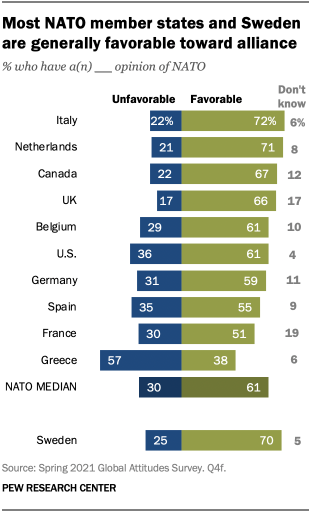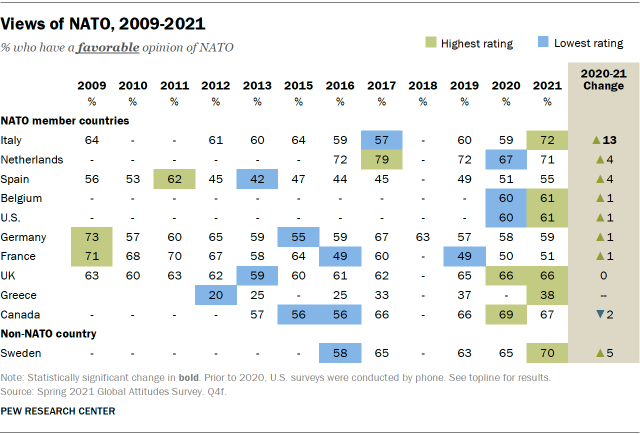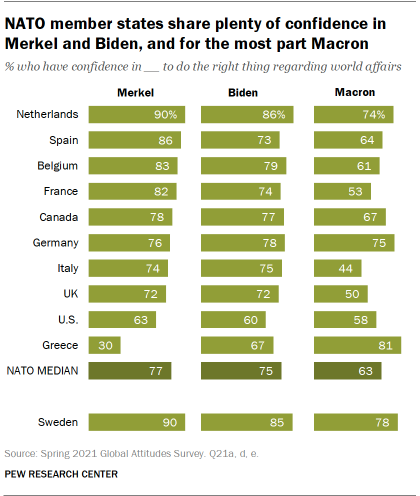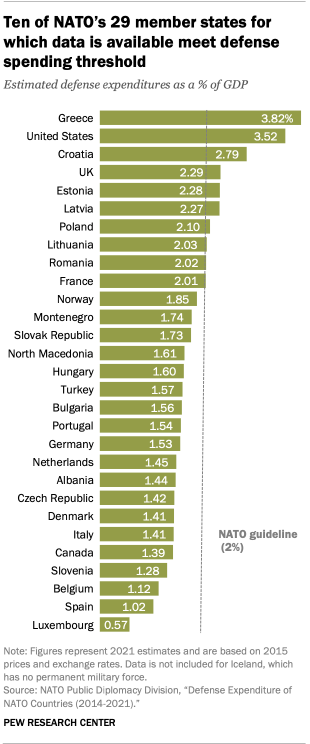As leaders across Europe and North America gather next week for the 2021 NATO summit, most across the 10 member states included in a new Pew Research Center survey see the political and military alliance in a positive light. Moreover, positive views of NATO are at or near all-time highs across several member states. Opinions among Americans, who contribute the most to NATO’s annual budget, are at 61% favorable, the same as the overall median across the NATO states surveyed.
In nine of the nations surveyed in 2021, about half or more hold a favorable opinion of the alliance. Two-thirds or more of adults in Italy, the Netherlands and Canada have a positive opinion of NATO, along with about six-in-ten or more in the United Kingdom, the United States, NATO’s home base of Belgium, and Germany. But in Greece, only 38% see NATO favorably.
In nonmember Sweden, 70% have a positive opinion of the more than 70-year-old alliance. Except in Greece, in no country surveyed do more than about a third have a negative view of NATO, although in many countries around one-in-ten hold no opinion of the multilateral organization.
Favorable opinions of NATO have generally held steady across most countries surveyed over the past year. And in many countries, positive attitudes toward NATO are at or near all-time highs since this question was first asked in 2009, including in Italy and the UK. Italy is the only NATO country surveyed in which positive views of the organization have increased significantly since the summer of 2020 (up 13 percentage points).
This analysis focuses on views of NATO. For this post, we conducted nationally representative surveys of 10,110 adults from March 12 to May 26, 2021, in 10 NATO member countries and nonmember Sweden. All surveys were conducted over the phone with adults in Canada, Belgium, France, Germany, Greece, Italy, the Netherlands, Spain, Sweden and the UK.
In the United States, we surveyed 2,596 U.S. adults from Feb. 1 to 7, 2021. Everyone who took part in this survey is a member of the Center’s American Trends Panel (ATP), an online survey panel that is recruited through national, random sampling of residential addresses. This way nearly all U.S. adults have a chance of selection. The survey is weighted to be representative of the U.S. adult population by gender, race, ethnicity, partisan affiliation, education and other categories.
This study was conducted in places where nationally representative telephone or web surveys are feasible. Due to the coronavirus outbreak, face-to-face interviewing is not currently possible in many parts of the world.
Here are the questions used for the report, along with responses. See our methodology database for more information about the survey methods outside the U.S. For respondents in the U.S., read more about the ATP’s methodology. Defense spending estimates come from the NATO Public Diplomacy Division.
While opinion of NATO in the U.S. is mostly unchanged over the past year, views before that had fluctuated from 49% favorable in 2013 to as high as 64% in 2018. However, these figures were from prior to 2020, when the surveys were done by phone and the Center had not yet switched to its online American Trends Panel, and are not directly comparable.
In every country surveyed, those with a favorable view of the U.S. are more likely than those with an unfavorable view of the U.S. to see NATO in a positive light. In Spain, for example, 68% of those with a favorable view of the U.S. also have a favorable view of NATO, compared with just 35% of those with an unfavorable view of America.
While Americans are more favorable toward NATO than not, partisans hold very different views of the alliance. Democrats and Democratic-leaning independents are much more likely than their Republican counterparts to have a positive assessment of NATO (77% vs. 44%, respectively). But within each partisan coalition in the U.S., there are few differences by ideology. Conservative Republicans are about as likely as moderate or liberal Republicans to have a favorable view of the organization. The same holds true for Democrats: Liberals are no more likely than conservative or moderates to have a positive view of NATO.
Generally, Democrats have been more keen on the military alliance than Republicans in phone surveys conducted since 2009. In addition, 71% of Americans say the U.S. benefits by being a member of NATO, including 55% of Republicans and 85% of Democrats.
Outside of the U.S., political attitudes are linked to views of the alliance, but in the opposite direction. In several European countries, those who place themselves on the ideological right are more favorable toward NATO than those on the ideological left. In Greece, for example, 48% of those on the right have a favorable view of the organization, compared with 23% of those on the left. This pattern also holds in non-NATO country Sweden, where those on the right are 31 percentage points more likely than those on the left to have a positive view of the alliance.
U.S. President Joe Biden will be attending the summit as part of his first overseas trip as president. Biden’s public statements reaffirming U.S. commitment to the organization stand in stark contrast with his predecessor’s more unfavorable views of NATO. Biden will also be meeting with the leaders of France and Germany on his trip, and new data shows that all three leaders are generally popular with the NATO publics surveyed.
Among NATO member countries, a median of 75% have confidence in Biden to do the right thing regarding world affairs. This compares with 77% who have confidence in German Chancellor Angela Merkel and 63% who have confidence in French President Emmanuel Macron. In most NATO countries included in the survey, along with Sweden, publics have roughly similar levels of confidence in Merkel and Biden, although Macron garners less in Italy. Greeks are enthusiastic toward the U.S. and French leaders: 67% say they have confidence in Biden and 81% have confidence in Macron. However, only 30% in Greece have confidence in Merkel.
Confidence in these three leaders’ ability to handle world affairs is also linked to views of NATO: Across most countries included, those who have confidence in Biden, Merkel and Macron are more likely than those who do not to hold a favorable opinion of NATO. In Canada, for example, those with confidence in Biden are 31 percentage points more likely than those with no confidence to have a positive view of NATO. And Canadians who have confidence in Merkel and Macron are 34 and 21 points more likely, respectively, to have a favorable view of NATO than those who do not have confidence in the German and French leaders.
NATO has established a guideline that member nations contribute a minimum of 2% of gross domestic product toward defense, as an indication of that nation’s commitment to the key goal of mutual protection and security. However, only about a third of NATO member states – 10 of 29 countries for which data is available – are estimated to meet this 2% guideline in 2021. (Data is not included for Iceland, which has no permanent military force.)
While the U.S. spends the most on this goal of all NATO member states (estimated to be over $725 billion in constant 2015 prices and exchange rates), Greece is contributing a higher share of its GDP to defense expenditures. Other states that meet or exceed this guideline include several across Central and Eastern Europe. And two additional top defense spenders – the UK and France – also meet this threshold.
But in Germany, where approximately 40,000 American troops are stationed to protect Europe from military threats, only 1.53% of the national budget is spent on defense. And a recent poll from Korber-Stiftung shows Germans are split on whether to increase their defense expenditures: 49% support boosting it to the 2% NATO guideline, while 45% are opposed.
Note: This post, originally published June 10, 2021, has been updated to include figures for member states’ defense contributions in 2021. Here are the questions used for this analysis, along with responses, and its international methodology, U.S. methodology, and full dataset.









